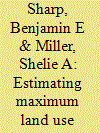| Srl | Item |
| 1 |
ID:
127224


|
|
|
|
|
| Publication |
2014.
|
| Summary/Abstract |
The maximum amount of land for growing switchgrass for ethanol is estimated for a region in the southeastern U.S. Breakeven capacities are calculated for land in row crops, hay, pasture and marginal land. Characteristics of land categories inform potential land use change impacts as well as switchgrass profitability. Variable yields within and across land categories are translated into distributions of switchgrass net revenue. Breakeven curves are generated for a range of switchgrass prices. These curves provide upper bounds for further analysis of actual switchgrass adoption in context of broader economic forces and possible policy mechanisms to minimize environmental impacts. A farm-gate price of $55 Mg?1 is estimated for half of marginal and pasturelands to break even with switchgrass. At this price, only 20% of land in hay and a small fraction of row crop hectares break even. Half of hay and row crops hectares break even at approximately $90 Mg?1 and $100 Mg?1, respectively. At $60 Mg?1, sufficient land area can profitably produce switchgrass for ethanol to displace approximately 10% of gasoline consumed in Georgia, North Carolina, and South Carolina; however, this price only indicates breakeven capacity implying that higher prices may be necessary to realize 10% displacement.
|
|
|
|
|
|
|
|
|
|
|
|
|
|
|
|
| 2 |
ID:
115151


|
|
|
|
|
| Publication |
2012.
|
| Summary/Abstract |
This study presents a linear profit model with combined economic and environmental factors for a switchgrass-for-biofuels agricultural system in the southeastern U.S. The objectives are to establish conversion-to-switchgrass thresholds for various market prices and identify policy incentives that would ensure economic profit while also maximizing environmental benefits (carbon sequestration, displacement of fossil fuels) and minimizing negative impacts (global warming potential, nitrate loss). Weighting factors are chosen to represent incentives and penalties by assigning value to the impacts. With no other incentives, switchgrass market prices of at least $51 and $58/dton would be needed in order to make a profitable switch from corn/Conservation Reserve Program (CRP) lands and cotton, respectively. At a mid-range offering of $50/dton, feasible carbon credit prices of $3/ $8/ $23 per metric tonne CO2e would incentivize conversion from corn, CRP, or cotton, respectively. Similarly, a water quality penalty of $0.20/ $3/ $2 per kilogram NO3-N leached would incentivize the same conversions with resultant watershed improvement. At a lower price of $30/dton switchgrass, incentives based on valuation of ecosystem services begin to exceed feasible ranges of these valuations.
|
|
|
|
|
|
|
|
|
|
|
|
|
|
|
|